Abstract
Faced with the depletion of fossil fuels and increasingly serious environmental pollution, finding an environmentally friendly renewable alternative fuel has become one of the current research focuses. In order to find new alternative fuels, reduce dependence on fossil fuels, improve air quality, and promote sustainable development goals, castor biodiesel was produced through transesterification, and mixed with diesel in a certain proportion. The engine performance and emissions were compared and analyzed under fixed load and different speeds of agricultural diesel engines. Biofuel, as a fuel containing oxygen, promotes complete combustion to a certain extent. As the proportion of castor biodiesel in the mixed fuel increases, the emissions of pollutants such as CO, HC, and smoke show a decreasing trend. The lowest CO, HC, and smoke emissions were observed in the B80 blend at 1800 rpm, at 0.3%, 23 ppm, and 3%, respectively. On the contrary, the CO2 and NOx emissions of the B80 blend are higher than those of 2.7 diesel, reaching 2.5% and 332 ppm respectively at 1800 rpm. The lower calorific value and higher viscosity of biodiesel result in a decrease in BTE and an increase in the BSFC of the blends. Higher combustion temperatures at high speeds promote oxidation reactions, resulting in reduced HC, CO, and smoke emissions, but increased CO2 and NOx emissions. At high speeds, fuel consumption increases, BSFC increases, and BTE decreases. Overall, castor biodiesel has similar physical and chemical properties to diesel and can be mixed with diesel in a certain proportion for use in CI engines, making it an excellent alternative fuel.
1. Introduction
Internal combustion engines, as the most common power system, can convert gas and liquid fuels into power and are divided into compression ignition and spark ignition engines. Compared with gasoline engines, CI engines have received unanimous praise for their high efficiency, high torque, and long service life in industries such as industry, agriculture, transportation, and navigation [1]. However, diesel is a non-renewable energy source, and its formation requires a long geological evolution process. With the rapid development of modern industrial civilization, the existing amount of fossil fuels has sharply decreased, leading to a continuous increase in diesel prices. According to the International Energy Agency’s forecast, crude oil prices will reach over $200 per barrel by 2030, which will lead to inflation, causing many households to become increasingly impoverished and even leading to some factories shutting down, resulting in a significant slowdown in economic development. In addition, diesel engines generate a large amount of exhaust emissions when generating power, which poses a threat to the ecological environment. This includes greenhouse gas emissions, accelerated climate change, and emissions of nitrogen oxides and particulate matter, which have a negative impact on air quality and ecological balance. According to data released by the International Energy Agency, it is expected that bioenergy will increase from 41 EJ to 75 EJ by 2030 and reach 100 EJ by 2050 [2]. The depletion of fossil fuels, climate change, and air pollution are driving us to seek alternative solutions for sustainable energy and environmentally friendly fuels. This environmental pressure has forced scholars from around the world to actively explore alternative fuels for diesel engines, hoping to find an environmentally friendly and renewable alternative fuel. To address this challenge, the research and application of biofuels have become one of the focuses.
Biodiesel has many remarkable characteristics among existing alternative fuels, which can be used without changing the structure of existing diesel engines. The similar physical and chemical properties of biodiesel and diesel enable it to use diesel infrastructure during transportation and storage. These advantages undoubtedly greatly reduce production costs and have extremely high economic efficiency. Compared with diesel fuel, the lower sulfur content, aromatics content, and higher oxygen content in biodiesel reduce HC and CO emissions [3,4]. In addition, biodiesel has an oxygen content of about 9–12%, which helps to effectively reduce the temperature of exhaust emissions and reduce emissions of carbon monoxide (CO), hydrocarbons (HC), and particulate matter [5]. This characteristic helps to improve air quality, reduce the concentration of harmful substances in the atmosphere, and is crucial for environmental protection. Secondly, polycyclic aromatic hydrocarbon emissions (PAH) have potential hazards due to their toxicity. In contrast, the components of biodiesel do not contain this harmful substance, which has a significant effect on reducing harmful gas emissions and reducing adverse effects on health and the environment [6]. Biodiesel is different from diesel fuel. As a renewable energy source, the raw materials used in its production can come from plants, algae, animal fats, and waste edible oil [7]. However, biodiesel releases oxygen during combustion, which to some extent increases the combustion temperature in the cylinder, promotes oxidation reactions between different atoms, and results in slightly higher NOx and CO2 emissions than diesel [8].
With the continuous deepening of understanding of biodiesel, countries around the world have increased the proportion of biofuels in diesel fuels. In the revised version of the Renewable Energy Directive issued by the European Union in 2018, it was mentioned that the proportion of renewable energy should reach 20% by 2020, and at least 10% of renewable energy should be used in road transportation. By 2030, this target will increase to 32%; Over the past 20 years, biofuels have accounted for over 30% of the transportation industry in the United States [9,10]. At present, the rise in raw material prices and the use of edible crops to produce biodiesel are the main factors restricting the development of the biodiesel industry. When selecting biodiesel raw materials, consideration should be given to their economy, oil content, and accessibility [11].
From the existing research results, it can be seen that the main source of biodiesel is still grain crops, such as soybean oil, rapeseed oil, palm oil, etc. [12,13,14]. The industrial chain for producing biodiesel from non-edible crops and catering waste has not yet formed, especially in developing countries where the collection of catering waste is particularly difficult. This undoubtedly greatly restricts the development of the biodiesel industry. In this article, we believe that using inedible crops to produce biodiesel also brings additional benefits, including lower production costs, reduced resource waste, increased variety of raw materials to choose from, greening of harsh terrain, and improved production sustainability. This has positive implications for the development of the automotive industry, energy sustainability, and environmental protection. Secondly, this strategy helps alleviate the shortage of food resources, as competition for food resources often leads to rising food prices and supply issues. Extracting biofuels from non-edible seed vegetable oil is carbon neutral because plants can absorb CO2 during their growth process, improving the greenhouse effect [15,16]. As a low-cost raw material, it can protect the environment while reducing costs. Castor plants are distributed around the world, with tall plants generally ranging from 2 to 4 m. The stems and leaves contain white milky juice, which can quickly reproduce in saline and sandy soil [7], achieving the original intention of not competing with food crops for land. Another huge advantage of castor plants is that their seeds have an oil content of up to 40–60%, coupled with their high yield, making them an extremely excellent non-edible oil crop. The various parts of the castor plant, especially the seeds, contain strong toxins [17], which can affect the synthesis of human proteins and cause serious consequences when in contact with the human body. After special processing, castor oil is generally used in the manufacturing of lubricants, soap, cosmetics, and pharmaceuticals. The process of extracting castor oil from castor seeds produces by-products such as Castor Meat. However, this article mainly focuses on the performance and emissions of castor biodiesel in diesel engines and has not conducted much research on by-products.
At present, the direct application of biodiesel in diesel engines has certain limitations, mainly due to its high density and viscosity, which can affect the flow and atomization effect of the fuel. The higher the viscosity of the fuel, the more energy is required for atomization, which will increase the fuel size after atomization, further leading to incomplete combustion, reduced engine performance, and increased exhaust emissions [18]. In addition, the calorific value of biodiesel is generally lower than that of diesel, and in order to achieve the same power output as diesel, more biodiesel fuel needs to be consumed. At present, in order to improve the above-mentioned drawbacks of biodiesel, methods such as mixing it in proportion to diesel or adding various catalysts are mainly used to improve engine efficiency and reduce emissions [19,20,21].
Castor oil has been shown to be one of the preferred choices for non-edible oils in the use and production of biodiesel under various conditions [22]. The use of non-edible vegetable oil biodiesel to solve food price problems is good [23]. In addition, compared to diesel fuel, castor biodiesel blends have lower emissions of harmful gases such as carbon monoxide (CO) and hydrocarbons (HC) [24]. Arunkumar et al. [25] believe that castor biodiesel, as a good alternative to diesel, can greatly reduce greenhouse gas emissions. Emissions of carbon monoxide, hydrocarbons, and nitrogen oxides are reduced to varying degrees compared to diesel. However, the fuel consumption rate and thermal efficiency performance are slightly inferior to diesel. More importantly, planting castor plants for carbon neutrality can provide more employment opportunities and stimulate urban development. Attia et al. [26] used transesterification ultrasonic technology to produce castor biodiesel and mixed it with traditional diesel in a certain proportion to meet ASTM requirements. The results in a single-cylinder diesel engine showed that at a 10% mixing ratio, there was an optimal reduction in exhaust emissions of carbon monoxide, unburned hydrocarbons, and nitrogen oxides. In addition, low smoke emission appeared at a 30% mixing ratio, carbon dioxide emissions decreased by 7.5% at a 20% mixing ratio, and BTE increased by approximately 1%. However, the BSFC of all mixed fuels was slightly higher than that of diesel fuels. Prasert Aengchuan et al. [27] used 10% castor oil, 10% ethanol, and 80% diesel to prepare a new blend. They found that 10% castor biodiesel can improve the shortcomings of diesel–ethanol blends. The combustion of the blend increased the emissions of hydrocarbons and carbon monoxide, but reduced the emissions of nitrogen oxides. Smoke emissions did not show significant changes.
By summarizing the research of previous researchers, it was found that previous studies mainly focused on the mixing of diesel and low-proportion castor biodiesel (B10, B20, and B30), while the mixing of diesel and high-proportion castor biodiesel is very rare. This undoubtedly reduces the comprehensive understanding of the performance and emissions of castor biodiesel on diesel engines. Therefore, in order to fill this gap, this article adopts the ester exchange method to produce castor biodiesel. The obtained biofuel is mixed with diesel in a certain proportion to prepare biodiesel–diesel blends (B20, B40, B60, and B80). A comparative analysis was conducted on the engine performance, combustion performance, exhaust emissions, and potential environmental and economic advantages of biodiesel blends and pure diesel on a single-cylinder water-cooled agricultural diesel engine with 25% constant load and different speeds (1200 rpm, 1400 rpm, 1600 rpm, and 1800 rpm). We hope this research can provide strong support for reducing dependence on fossil fuels, improving air quality, reducing greenhouse gas emissions, and promoting the achievement of sustainable development goals.
2. Materials and Methods
2.1. Experimental Equipment
This experiment was conducted at constant loads (25%) and different speeds (1200 rpm, 1400 rpm, 1600 rpm, and 1800 rpm). The experiment used a water-cooled single-cylinder four-stroke mechanical diesel engine with a rated power of 7.4 kW, which is widely used in the agricultural field. The experimental engine is installed on the test bench, and the eddy current dynamometer is connected to the engine crankshaft to apply a load to the engine during the experiment. The schematic layout of experimental instruments and detailed engine parameters are detailed in Figure 1 and Table 1.
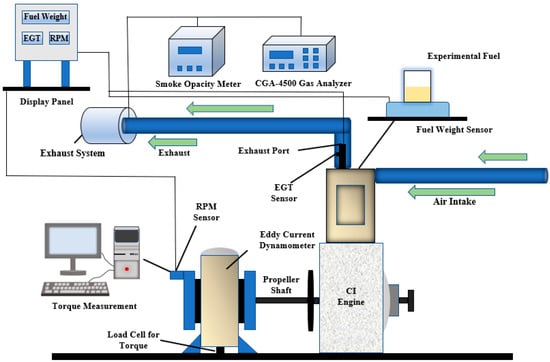
Figure 1.
Experimental setup.

Table 1.
Engine parameters.
The analysis and measurement of exhaust emissions are carried out using a gas analyzer (CGA-4500), which operates by inserting the probe of the gas analyzer into the exhaust pipe and drawing the exhaust gas into the condenser through the gas sampling probe. Subsequently, the gas passes through a particle filter to filter out impurities and enters the sensing chamber of the gas analyzer. The final measurement results are displayed on the display screen and available for reading. To detect engine smoke, we use a smokemeter (BS-8000). Its usage method is similar to the CGA-4500 gas analyzer. By connecting the smoke meter to the exhaust pipe, a sample of exhaust gas is obtained, and then smoke detection is performed. The measurement of exhaust gas emission temperature adopts a K-type thermocouple with a measurement range of 0–1200 °C. The thermocouple is placed in the exhaust manifold to obtain accurate exhaust gas temperature data.
2.2. Production Methods and Processes of Castor Biodiesel
The production of biodiesel involves chemical reactions, among which the transesterification reaction is one of the most commonly used methods in laboratory and industrial production. This process utilizes methanol, promoted by a catalyst, to convert free fatty acids (FFA), oil, or fats into corresponding proportions of fatty acid methyl esters (FAME) [28,29]. The principle of the transesterification process is shown in Figure 2.

Figure 2.
Transesterification process [30].
Among the various catalysts used in transesterification, homogeneous catalysts such as potassium hydroxide (KOH) and sodium hydroxide (NaOH) are known for their advantages such as short reaction time, low reaction temperature, high productivity, and high catalytic activity [31]. In recent years, the use of heterogeneous catalysts has gradually increased. Unlike homogeneous catalysts, the significant advantage of heterogeneous catalysts lies in their reusability, which helps to effectively reduce production costs. However, it should be noted that the reaction rate of multiphase catalysts is relatively slow [32]. The catalyst used in this study is KOH. Biodiesel has a higher density and viscosity compared to traditional diesel, which is well known. The process of generating biodiesel through transesterification reactions not only helps to better adapt biodiesel to engine systems, but also improves fuel fluidity and combustion efficiency. It is worth noting that excessive use of catalysts in transesterification reactions can form soap, which hinders the reaction process and reduces biodiesel production [33]. Therefore, it is important to use an appropriate amount of catalyst in transesterification reactions.
In the production of castor biodiesel, 125 mL of methanol and 2.5 g of potassium hydroxide catalyst are added to every 500 mL of castor plant oil, and they are placed on a mixer for two hours of transesterification reaction at a constant speed of 700 rpm and a constant temperature of 55 °C–60 °C. After the reaction, the solution is left to stand overnight. After removing the glycerol mixture at the bottom, the remaining part is washed with boiling water to filter out impurities. After the excess water evaporates, the resulting liquid is castor biodiesel.
2.3. Experimental Fuel Characteristics
The physical and chemical properties of the fuel used in this experiment are shown in Table 2. From the table, it can be seen that the kinematic viscosity and density of castor biodiesel are higher than those of diesel fuel, and they have a certain impact on the flow and atomization of the fuel. In addition, the calorific value of castor biodiesel is generally lower than that of diesel fuel, which makes the fuel consumption of biodiesel blends higher than that of diesel fuel. The cetane value of biodiesel is higher than that of diesel, which to some extent improves engine power output, optimizes engine performance, and reduces emissions. Meanwhile, its high flash point gives biodiesel a significant advantage in transportation and storage. Overall, biodiesel blends have similar physical and chemical properties to diesel, making them an excellent alternative fuel.

Table 2.
Properties of diesel and castor seed biodiesel.
2.4. Error Analysis and Uncertainty
During experiments, experimental errors caused by various factors such as environment, atmospheric pressure, and temperature are inevitable and can have a certain impact on the experimental results. In order to avoid these impacts as much as possible and obtain more accurate experimental data, we started the experimental engine and adjusted the parameters during the experiment, then started data collection after it ran smoothly. Data were collected every two minutes for a total of four times; finally, the average value was taken. At the end of each stage of the experiment, the corresponding parameters were adjusted and the above process was repeated to ensure the accuracy of the results. Table 3 provides detailed information on the measurement range and uncertainty analysis of the gas analyzer and K-type thermocouple used in this experiment.

Table 3.
Measurement and error range of experimental equipment.
3. Results and Analysis
3.1. Carbon Monoxide (CO)
CO emissions are one of the important parameters for measuring engine emissions, representing the loss of chemical energy in the engine [34]. Figure 3 shows a schematic diagram of the changes in different proportions of blends at different speeds. It can be observed that the CO emissions of biodiesel blends are lower than those of diesel fuel at different speeds. It is worth noting that as the proportion of biodiesel increases, the CO emissions show a decreasing trend. At all four speeds, the CO emissions of the B80 mixed fuel are their lowest, at 0.56%, 0.44%, 0.37%, and 0.3%, respectively. The main reason for this phenomenon is that after adding biodiesel, the mixed fuel becomes oxygenated and the cetane number of the mixed fuel increases. The high cetane value and oxygen content characteristics enable the fuel to reach the conditions for spontaneous ignition faster, thereby shortening the ignition delay, improving combustion efficiency during the combustion stage, increasing combustion uniformity, stimulating fuel combustion in the cylinder, increasing combustion temperature, and promoting oxidation reactions, reducing CO emissions. As the engine speed increased from 1200 rpm to 1800 rpm, the CO emissions of all fuels showed a decreasing trend. Diesel fuel decreased from 0.76% at 1200 rpm to 0.45% at 1800 rpm, while the B80 blend decreased from 0.56% at 1200 rpm to 0.3% at 1800 rpm. This can be explained by the better mixing effect of air and fuel at higher speeds, promoting complete combustion. Other authors have also found similar experimental results, similar to HC emissions, the CO emissions of blends have also decreased, as oxygen increases combustion temperature and improves fuel atomization at high temperatures [19].

Figure 3.
Variation of CO at different engine speeds and blends.
3.2. Hydrocarbon (HC)
Figure 4 describes the relationship between engine speed and biodiesel-specific gravity on HC emissions. From the observation results, the maximum HC emissions of diesel engines at each speed are higher than those of biodiesel blends, which are 55 ppm, 48 ppm, 41 ppm, and 33 ppm, respectively. Compared to this, B80 exhibits the lowest CO emissions at 39 ppm, 36 ppm, 27 ppm, and 23 ppm at various speeds, respectively. The higher oxygen content and cetane number in biodiesel blends promote combustion and oxidation reactions, and the combination of a large number of hydrogen and oxygen atoms to form H2O is considered the main reason for the above phenomenon. In addition, the lower hydrocarbon ratio of biodiesel is also an important factor in reducing HC emissions [6]. As the speed increases, we observe that all fuel HC emissions decrease to varying degrees. This can be attributed to the better ignition of the air–fuel mixture in the cylinder at higher speeds, resulting in more complete combustion. The increase in combustion temperature means that more fuel is discharged in the form of CO2 and H2O, rather than partially burned HC. Compared with the results of other authors, we observed a similar emission trend, that is, the HC emissions of castor biodiesel blend fuel are lower than diesel, which further confirms the fact that the HC emissions of biodiesel fuel are lower [24,35].
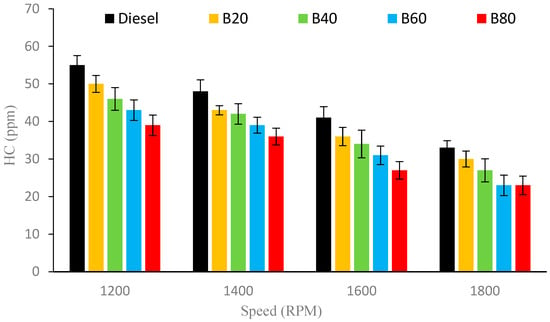
Figure 4.
Variation of HC at different engine speeds and blends.
3.3. Carbon Dioxide (CO2)
Figure 5 is a schematic diagram of the variation of CO2 emissions with engine speed and biodiesel ratio. As the proportion of castor biodiesel in blends increases, CO2 emissions show an increasing trend. On the one hand, the cetane value of biodiesel blends is higher than that of diesel, which reduces the possibility of fuel enrichment and detonation during combustion, optimizing combustion. On the other hand, biodiesel blends release oxygen during combustion, increase combustion temperature, promote oxidation reaction, and a large amount of CO is converted into CO2. In addition, it was found that all experimental fuels released more CO2 with increasing rotational speed. At 1200 rpm, diesel CO2 emissions were 1%, while B80 blend emissions were 2.1%. When rotational speed increased to 1800 rpm, diesel and B80 blend CO2 emissions were measured as 2% and 2.5%, respectively. As the engine speed increases, the consumption of biodiesel blends significantly increases, which is an important reason for the increase in CO2 emissions. In addition, at low speeds, there is less air involved in combustion, and the fuel cannot be fully burned. As the speed increases, more air is involved in combustion at the same fuel volume, improving the air–fuel mixture quality, allowing the fuel to burn completely and producing more CO2 emissions. Ramozon Khujamberdiev et al. [36] also found the same trend in CO2 emissions, which undoubtedly further confirms the accuracy of the experimental results.
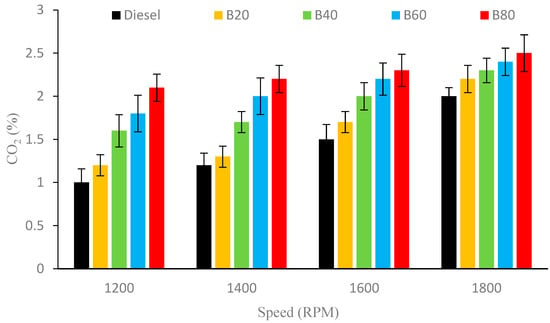
Figure 5.
Variation of CO2 at different engine speeds and blends.
3.4. Nitrogen Oxide Compound (NOx)
Figure 6 compares the changes in NOx emissions of diesel fuel at different speeds and ratios of blends. At speeds of 1200 rpm, 1400 rpm, 1600 rpm, and 1800 rpm, the NOx emissions of diesel fuel are 103 ppm, 130 ppm, 172 ppm, and 275 ppm; The NOx emissions of the B80 blend are displayed as 160 ppm, 193 ppm, 231 ppm, and 332 ppm. The results showed that diesel fuel maintained the lowest NOx emissions at all speeds, while the B80 blend had the highest NOx emissions. The oxygen content and flame temperature in the cylinder play a crucial role in the formation of NOx. Biodiesel blends have extremely high oxygen content; oxygen participation in combustion promotes combustion, increasing combustion temperature and reacting with nitrogen atoms, accelerating the rate of NOx production. When the engine is running at low speed, the combustion temperature is lower, and the NOx emissions of all experimental fuels are significantly lower. As the speed increases, more fuel is drawn into the cylinder, and the amount of air involved in combustion also increases significantly, resulting in a significant increase in NOx emissions. Compared with the research results of other scholars, the phenomenon of NOx emissions from castor biodiesel blends has also been found. Mohammed Kareemullah et al. [37] attributed this to the increase in combustion temperature caused by oxygen release, promoting NOx formation, which is consistent with our viewpoint.
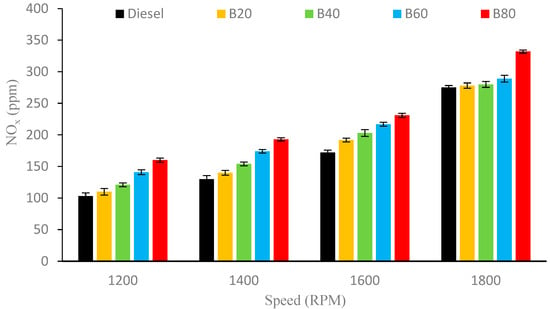
Figure 6.
Variation of NOx at different engine speeds and blends.
3.5. Smoke
Figure 7 shows the smoke emissions of diesel and biodiesel blends with different proportions at different speeds. It can be observed that all fuels have higher smoke emissions. This is because mechanical diesel engines lack advanced control systems in terms of fuel injection timing and quantity, and the lower combustion temperature at low loads is also one of the important reasons. Compared with diesel, the smoke emissions of all biodiesel blends have been reduced. At a speed of 1800 rpm, diesel fuel has the highest smoke emissions, showing 9.1%. The smoke emissions of B20, B40, B60, and B80 blends are 6.8%, 6.9%, 4.6%, and 2.7%, respectively, which are 28.4%, 27.4%, 51.6%, and 72.6% lower than diesel. This is because the high cetane number and high oxygen content of biodiesel enable faster combustion of the fuel after compression and injection, improving combustion efficiency and reducing smoke emissions. At low engine speeds, the smoke emissions of all experimental fuels are higher, indicating that the fuel has not been completely burned. As the speed increases, the air–fuel mixture in the combustion chamber becomes more uniform and the combustion becomes more thorough. The smoke emissions gradually decrease, and the lowest smoke emissions are obtained at 1800 rpm, which are 9.5%, 6.8%, 6.9%, 4.6%, and 2.7%, respectively. Mohamed Qinawy et al. [38] found similar smoke emission trends when studying the emissions of castor biodiesel fuel in engines. All biodiesel blends had relatively low smoke emissions, and they believed that biodiesel contained lower C-to-H components, which not only reduced HC and CO, but also reduced smoke concentration in the exhaust gas.
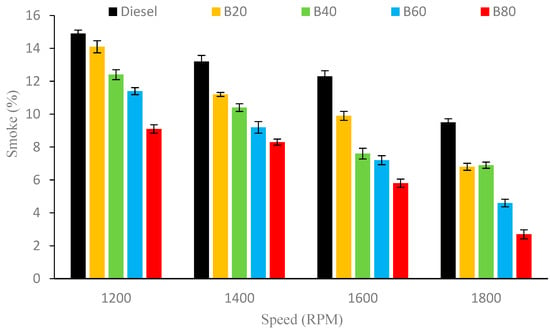
Figure 7.
Variation of smoke at different engine speeds and blends.
3.6. Brake Thermal Efficiency (BTE)
As shown in Figure 8, diesel has the highest BTE among all experimental fuels, with values of 23.22%, 22.25%, 20.99%, and 19.77% at 1200 rpm, 1400 rpm, 1600 rpm, and 1800 rpm, respectively. As the proportion of biodiesel in the blend increases, BTE shows a decreasing trend, while the B80 blend shows values of 18.99%, 17.93%, 17.38%, and 16.76%, respectively. This is because, compared to diesel, biodiesel has a higher density and kinematic viscosity, lower calorific value, and reduces combustion efficiency while increasing fuel consumption, which to some extent has a negative impact on EGT. At low speeds, the BTE of all fuels is higher, and as the speed increases, the BTE tends to decrease because the intake and exhaust times are relatively short at high speeds, and the energy generated by fuel combustion cannot be fully converted into useful work, thereby affecting combustion efficiency. In addition, mechanical losses (such as friction losses and pumping losses) are high at higher speeds, which cannot be converted into useful output power, resulting in a decrease in BTE to some extent. Tafsirul Hassan et al. [39] studied the engine performance of castor biodiesel, they found a similar trend. They found that the BTE of B10 fuel was lower than that of diesel fuel. However, when they added Ni and Ai nanoparticles in the form of additives to the blends, the BTE of the mixed fuel was higher than that of diesel fuel.
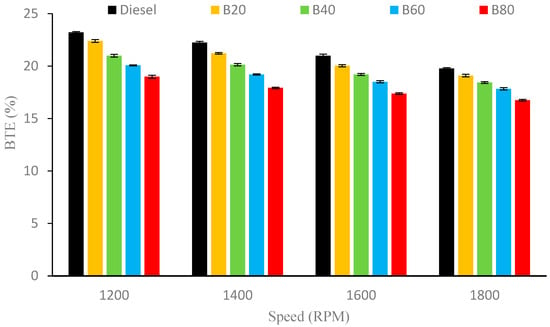
Figure 8.
Variation of BTE at different engine speeds and blends.
3.7. Brake Specific Fuel Consumption (BSFC)
Figure 9 illustrates the variation of BSFC with the proportion of biodiesel and speed. Comparing the BSFC of five fuels at the same speed, it can be seen that diesel fuel always maintains the lowest BSFC at all speeds. At 1800 rpm, the BSFC of the five experimental fuels are 4 kg/W·h, 4.24 kg/W·h, 4.45 kg/W·h, 4.86 kg/W·h, and 5.35 kg/W·h, respectively. It is worth noting that as the proportion of biodiesel increases, BSFC also increases. Higher BSFC is due to the decrease in the calorific value of the blend caused by the increase in the proportion of biodiesel, which requires more fuel consumption to generate the same power. In addition, the higher density and viscosity of biodiesel are also important factors in causing higher BSFC. The higher density and viscosity lead to reduced volatility, a reduced atomization effect, and improper mixing. As the rotational speed increases, the power generated by each fuel unit decreases, and the BSFC of all five experimental fuels shows an increasing trend. Muteeb ul Haq et al. [40] and Jonah Chukwudi Umeuzuegbu et al. [41] also found the same trend in BSFC variation when studying castor biodiesel blends.
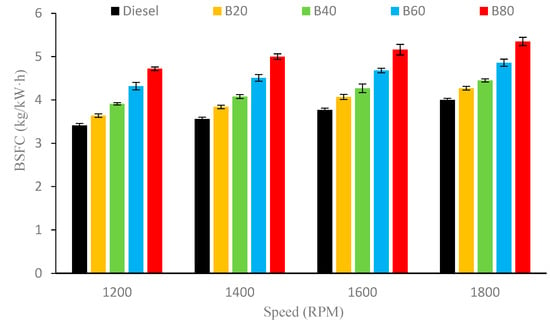
Figure 9.
Variation of BSFC at different engine speeds and blends.
3.8. Exhaust Gas Temperature (EGT)
The effect of the biodiesel ratio on EGT at different speeds is shown in Figure 10. It can be observed that the EGT of diesel fuel is always the highest at different engine speeds, showing 214 °C, 234 °C, 245 °C, and 269 °C at 1200 rpm, 1400 rpm, 1600 rpm, and 1800 rpm, respectively. In contrast, the B80 blend has the lowest EGT at 131 °C, 155 °C, 174 °C, and 192 °C, respectively. This is because biodiesel has a higher cetane value, shorter ignition delay, sufficient fuel combustion time, and lower EGT. As the engine speed increases, the EGT of diesel, B20, B40, B60, and B80 increases from 214 °C, 182 °C, 160 °C, 139 °C, and 131 °C at 1200 rpm to 269 °C, 230 °C, 214 °C, 201 °C, and 192 °C at 1800 rpm, respectively. On the one hand, an increase in engine speed means that the amount of fuel burned per minute also increases. More fuel is ignited in a short period of time, resulting in more heat generation and an increase in the speed of exhaust gas passing through the exhaust system, reducing the time for heat loss and making the exhaust gas stay in the exhaust system for a shorter period of time resulting in an increase in temperature. This will increase EGT. On the other hand, the engine BTE decreases during high-speed operation, and the fuel generates more heat, which is also an important factor leading to an increase in exhaust emission temperature. Compared with the experimental results of other authors, the same phenomenon was also found, further confirming the conclusion that diesel has the highest EGT, while biodiesel blends have lower EGT [23].
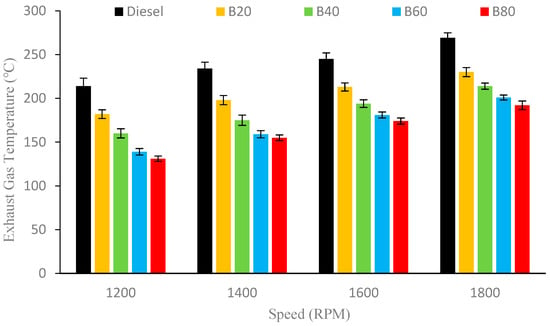
Figure 10.
Variation of EGT at different engine speeds and blends.
4. Conclusions
In order to search for new alternative fuels, this article uses castor plant oil as raw material and manufactures castor biodiesel through the transesterification method. The obtained biodiesel and diesel are mixed into B0, B20, B40, B60, and B80 blends in a certain proportion. Experiments are conducted using an agricultural diesel engine at a fixed load and different speeds.
When using biodiesel blends, the CO, HC, and smoke in the exhaust gas show a decreasing trend. Among them, the B80 blend observed the lowest CO, HC, and smoke emissions at 1800 rpm, which were 0.3%, 23 ppm, and 2.7%, respectively. This is because biodiesel, as an oxygen-containing fuel, promotes complete combustion to a certain extent. On the contrary, the CO2 and NOx emissions of the B80 blend are higher than those of diesel, reaching 2.5% and 332 ppm respectively at 1800 rpm. As the proportion of castor biodiesel in the biodiesel blend increases, BTE decreases and BSFC increases, due to the lower calorific value and higher kinematic viscosity of biodiesel.
As the speed increases, the higher combustion temperature at high speeds leads to a decreasing trend in CO, HC, and smoke. During this process, high temperatures promote oxidation reactions, resulting in an increase in CO2 and NOx emissions. High-speed rotation means more fuel consumption, an increase in BSFC, and a decrease in BTE.
The authors of this article believe that the physical and chemical properties of castor biodiesel blends are relatively similar to diesel, and they can be used without changing the structure of existing CI engines. The high cetane number and high oxygen content of biodiesel fuel effectively shorten the ignition delay of the fuel and increase combustion stability; additionally, the high flash point makes its transportation and storage extremely convenient. However, the high viscosity, density, and low calorific value of biodiesel have a certain impact on engine performance and emissions. We will explore solutions in future research, such as multi-fuel blends, the use of nano additives, antioxidants, etc.
The cultivation of castor plants can provide farmers with a new economic source without affecting food crops, and the development of its related industrial chain will also promote urban employment and economic development. Its low cost, easy survival, high yield, and high oil content make it a low commercial risk and widely used renewable fuel.
Author Contributions
Conceptualization, F.Z.; methodology, F.Z.; software, F.Z.; validation, F.Z. and H.M.C.; formal analysis, F.Z.; investigation, F.Z.; resources, H.M.C.; data curation, F.Z.; writing—original draft preparation, F.Z.; writing—review and editing, F.Z. and H.M.C.; visualization, F.Z.; supervision, H.M.C.; project administration, H.M.C.; funding acquisition, H.M.C. All authors have read and agreed to the published version of the manuscript.
Funding
This work was supported by the National Research Foundation of Korea (NRF) grant funded by the Korean government (MSIT) (NRF-2022H1A7A2A02000033).
Data Availability Statement
The data presented in this study were collected from the experimental investigation by the first author.
Acknowledgments
The National Research Foundation of Korea (NRF) funded by the Korean government (MSIT) (NRF-2019R1A2C1010557) supported this work.
Conflicts of Interest
The authors declare no conflicts of interest.
Nomenclature
| RPM | Revolutions Per Minute |
| PPM | Parts Per Million |
| KOH | Potassium Hydroxide |
| NaOH | Sodium Hydroxide |
| BTE | Brake Thermal Efficiency |
| EGT | Exhaust Gas Temperature |
| BSFC | Brake Specific Fuel Consumption |
| NOx | Nitrogen Oxide |
| CO | Carbon Monoxide |
| CO2 | Carbon Dioxide |
| HC | Hydrocarbon |
| B80 | 80% Biodiesel + 20% Diesel |
| B60 | 60% Biodiesel + 40% Diesel |
| B40 | 40% Biodiesel + 60% Diesel |
| B20 | 20% Biodiesel + 80% Diesel |
References
- Winangun, K.; Setiyawan, A.; Sudarmanta, B.; Puspitasari, I.; Dewi, E.L. Investigation on the properties of a biodiesel-hydrogen mixture on the combustion characteristics of a diesel engine. Case Stud. Chem. Environ. Eng. 2023, 8, 100445. [Google Scholar] [CrossRef]
- Mohite, A.; Bora, B.J.; Sharma, P.; Medhi, B.J.; Barik, D.; Balasubramanian, D.; Nguyen, V.G.; Femilda Josephin, J.S.; Le, H.C.; Kamalakannan, J.; et al. Maximizing efficiency and environmental benefits of an algae biodiesel-hydrogen dual fuel engine through operational parameter optimization using response surface methodology. Int. J. Hydrogen Energy 2024, 52, 1395–1407. [Google Scholar] [CrossRef]
- Gad, M.S.; Ismail, M.A. Effect of waste cooking oil biodiesel blending with gasoline and kerosene on diesel engine performance, emissions and combustion characteristics. Process Saf. Environ. Prot. 2021, 149, 1–10. [Google Scholar] [CrossRef]
- Gad, M.S.; EL-Seesy, A.I.; Radwan, A.; He, Z. Enhancing the combustion and emission parameters of a diesel engine fueled by waste cooking oil biodiesel and gasoline additives. Fuel 2020, 269, 117466. [Google Scholar] [CrossRef]
- Shrivastava, P.; Verma, T.N. An experimental investigation into engine characteristics fueled with Lal ambari biodiesel and its blends. Therm. Sci. Eng. Prog. 2020, 17, 100356. [Google Scholar] [CrossRef]
- Bukkarapu, K.R.; Krishnasamy, A. Support vector regression approach to optimize the biodiesel composition for improved engine performance and lower exhaust emissions. Fuel 2023, 348, 128604. [Google Scholar] [CrossRef]
- Aslan, V. Fuel characterization, engine performance characteristics and emissions analysis of different mustard seed biodiesel: An overview. J. Biotechnol. 2023, 370, 12–30. [Google Scholar] [CrossRef]
- Aydin, H.; İlkılıç, C. Effect of ethanol blending with biodiesel on engine performance and exhaust emissions in a CI engine. Appl. Therm. Eng. 2010, 30, 1199–1204. [Google Scholar] [CrossRef]
- Yaşar, F. Biodiesel production via waste eggshell as a low-cost heterogeneous catalyst: Its effects on some critical fuel properties and comparison with CaO. Fuel 2019, 255, 115828. [Google Scholar] [CrossRef]
- Lin, C.-Y.; Lu, C. Development perspectives of promising lignocellulose feedstocks for production of advanced generation biofuels: A review. Renew. Sustain. Energy Rev. 2021, 136, 110445. [Google Scholar] [CrossRef]
- Carmona-Cabello, M.; Sáez-Bastante, J.; Pinzi, S.; Dorado, M.P. Optimization of solid food waste oil biodiesel by ultrasound-assisted transesterification. Fuel 2019, 255, 115817. [Google Scholar] [CrossRef]
- de Souza, T.A.Z.; Pinto, G.M.; Julio, A.A.V.; Coronado, C.J.R.; Perez-Herrera, R.; Siqueira, B.O.P.S.; da Costa, R.B.R.; Roberts, J.J.; Palacio, J.C.E. Biodiesel in South American countries: A review on policies, stages of development and imminent competition with hydrotreated vegetable oil. Renew. Sustain. Energy Rev. 2022, 153, 111755. [Google Scholar] [CrossRef]
- da Silva César, A.; Conejero, M.A.; Ribeiro, E.C.B.; Batalha, M.O. Competitiveness analysis of “social soybeans” in biodiesel production in Brazil. Renew. Energy 2019, 133, 1147–1157. [Google Scholar] [CrossRef]
- Faba, E.M.S.; Ferrero, G.O.; Ferrero, G.O.; Eimer, G.A. Alternative Raw Materials to Produce Biodiesel through Alkaline Heterogeneous Catalysis. Catalysts 2019, 9, 690. [Google Scholar] [CrossRef]
- Vijayan, S.; Sathyamurthy, R.; Mokheimer, E.M.A.; Kumar, R.S. Performance enhancement and emission reduction of CRDI diesel engine fueled using Manilkara Zapota biodiesel blend with TiO2 nanoadditive. Fuel Process. Technol. 2023, 248, 107842. [Google Scholar] [CrossRef]
- Leo, G.M.L.; Jayabal, R.; Srinivasan, D.; Das, M.C.; Ganesh, M.; Gavaskar, T. Predicting the performance and emissions of an HCCI-DI engine powered by waste cooking oil biodiesel with Al2O3 and FeCl3 nano additives and gasoline injection—A random forest machine learning approach. Fuel 2024, 357 Pt B, 129914. [Google Scholar]
- Sousa, N.L.; Cabral, G.B.; Vieira, P.M.; Baldoni, A.B.; Aragão, F.J.L. Bio-detoxification of ricin in castor bean (Ricinus communis L.) seeds. Sci. Rep. 2017, 7, 15385. [Google Scholar] [CrossRef] [PubMed]
- Badra, J.; Zubail, A.; Sim, J. Numerical Investigation into Effects of Fuel Physical Properties on GCI Engine Performance and Emissions. Energy Fuels 2019, 33, 10267–10281. [Google Scholar] [CrossRef]
- Deep, A.; Sandhu, S.S.; Chander, S. Experimental investigations on castor biodiesel as an alternative fuel for single cylinder compression ignition engine. Environ. Prog. Sustain. Energy 2017, 36, 1139–1150. [Google Scholar] [CrossRef]
- Çalhan, R.; Ergani, S.K.; Uslu, S. Synthesis of Fe–Ni–TiO2/activated carbon nanoparticles and evaluation of catalytic activity in a palm oil/diesel fuel blended diesel engine and optimization with RSM. Sci. Technol. Energy Transit. 2023, 78, 16. [Google Scholar] [CrossRef]
- Kivevele, T.T.; Mbarawa, M.M.; Bereczky, A.; Laza, T.; Madarasz, J. Impact of antioxidant additives on the oxidation stability of biodiesel produced from Croton Megalocarpus oil. Fuel Process. Technol. 2011, 92, 1244–1248. [Google Scholar] [CrossRef]
- Rana, Q.U.A.; Irfan, M.; Ahmed, S.; Hasan, F.; Shah, A.A.; Khan, S.; Rehman, F.U.; Khan, H.; Ju, M.; Li, W.; et al. Bio-catalytic transesterification of mustard oil for biodiesel production. Biofuels 2022, 13, 69–76. [Google Scholar] [CrossRef]
- Attia, A.M.A.; Kulchitskiy, A.R.; Nour, M.; El-Seesy, A.I.; Nada, S.A. The influence of castor biodiesel blending ratio on engine performance including the determined diesel particulate matters composition. Energy 2022, 239 Pt A, 121951. [Google Scholar] [CrossRef]
- Kondaiah, A.; Rao, Y.S.; Satishkumar; Kamitkar, N.D.; Ibrahim, S.J.A.; Chandradass, J.; Kannan, T.T.M. Influence of blends of castor seed biodiesel and diesel on engine characteristics. Mater. Today Proc. 2021, 45 Pt 7, 7043–7049. [Google Scholar] [CrossRef]
- Arunkumar, M.; Kannan, M.; Murali, G. Experimental studies on engine performance and emission characteristics using castor biodiesel as fuel in CI engine. Renew. Energy 2019, 131, 737–744. [Google Scholar] [CrossRef]
- Attia, A.M.A.; Nour, M.; Nada, S.A. Study of Egyptian castor biodiesel-diesel fuel properties and diesel engine performance for a wide range of blending ratios and operating conditions for the sake of the optimal blending ratio. Energy Convers. Manag. 2018, 174, 364–377. [Google Scholar] [CrossRef]
- Aengchuan, P.; Wiangkham, A.; Klinkaew, N.; Theinnoi, K.; Sukjit, E. Prediction of the influence of castor oil–ethanol–diesel blends on single-cylinder diesel engine characteristics using generalized regression neural networks (GRNNs). Energy Rep. 2022, 8 (Suppl. S15), 38–47. [Google Scholar] [CrossRef]
- Tacias-Pascacio, V.G.; Torrestiana-Sánchez, B.; Magro, L.D.; Virgen-Ortíz, J.J.; Suárez-Ruíz, F.J.; Rodrigues, R.C.; Fernandez-Lafuente, R. Comparison of acid, basic and enzymatic catalysis on the production of biodiesel after RSM optimization. Renew. Energy 2019, 135, 1–9. [Google Scholar] [CrossRef]
- Sukpancharoen, S.; Katongtung, T.; Rattanachoung, N.; Tippayawong, N. Unlocking the potential of transesterification catalysts for biodiesel production through machine learning approach. Bioresour. Technol. 2023, 378, 28961. [Google Scholar] [CrossRef]
- Zhang, W.; Wang, C.; Luo, B.; He, P.; Zhang, L.; Wu, G. Efficient and economic transesterification of waste cooking soybean oil to biodiesel catalyzed by outer surface of ZSM-22 supported different Mo catalyst. Biomass Bioenergy 2022, 167, 106646. [Google Scholar] [CrossRef]
- Bahadorian, A.; Sadrameli, S.M.; Pahlavanzadeh, H.; Kashkouli, M.N.I. Optimization study of linseed biodiesel production via in-situ transesterification and slow pyrolysis of obtained linseed residue. Renew. Energy 2023, 203, 10–19. [Google Scholar] [CrossRef]
- Maleki, B.; Talesh, S.S.A.; Mansouri, M. Comparison of catalysts types performance in the generation of sustainable biodiesel via transesterification of various oil sources: A review study. Mater. Today Sustain. 2022, 18, 100157. [Google Scholar] [CrossRef]
- Suzihaque, M.U.H.; Syazwina, N.; Alwi, H.; Ibrahim, U.K.; Abdullah, S.; Haron, N. A sustainability study of the processing of kitchen waste as a potential source of biofuel: Biodiesel production from waste cooking oil (WCO). Mater. Today Proc. 2022, 63 (Suppl. S1), S484–S489. [Google Scholar] [CrossRef]
- Karkal, S.S.; Jamadar, A.S.; Kudre, T.G. Valorization of marine fishmeal industry oil as feedstock and calcined shrimp and crab shells as catalysts for production of biodiesels and evaluation of their fuel properties, engine combustion, performance and gas emission characteristics. Process Saf. Environ. Prot. 2023, 182, 443–455. [Google Scholar] [CrossRef]
- Chidambaranathan, B.; Gopinath, S.; Aravindraj, R.; Devaraj, A.; Krishnan, S.G.; Jeevaananthan, J.K.S. The production of biodiesel from castor oil as a potential feedstock and its usage in compression ignition Engine: A comprehensive review. Mater. Today Proc. 2020, 33 Pt 1, 84–92. [Google Scholar] [CrossRef]
- Khujamberdiev, R.; Cho, H.M.; Mahmud, M.I. Experimental Investigation of Single-Cylinder Engine Performance Using Biodiesel Made from Waste Swine Oil. Energies 2023, 16, 7891. [Google Scholar] [CrossRef]
- Kareemullah, M.; Afzal, A.; Rehman, K.F.; Shahapurkar, K.; Khan, H.; Akram, N. Performance and emission analysis of compression ignition engine using biodiesels from Acid oil, Mahua oil, and Castor oil. Heat Transf. 2019, 49, 858–871. [Google Scholar] [CrossRef]
- Qenawy, M.; Khalaf, M.; Wang, J.; Tian, J.; Zuo, L.; Mustafa, H.M.M.; Esmail, M.F.C. Performance and emission of extracted biodiesel from mixed Jatropha-Castor seeds. Fuel 2024, 357 Pt C, 130060. [Google Scholar] [CrossRef]
- Hassan, T.; Rahman, M.M.; Adib, A.R.; Meraz, R.M.; Rahman, M.A.; Tushar, M.S.H.K. Effect of Ni and Al nanoadditives on the performance and emission characteristics of a diesel engine fueled with diesel-castor oil biodiesel-n-butanol blends. Case Stud. Chem. Environ. Eng. 2023, 8, 100531. [Google Scholar] [CrossRef]
- Haq, M.U.; Jafry, A.T.; Ahmad, S.; Cheema, T.A.; Kamran, M.; Ajab, H.; Masjuki, H.H. Macroscopic spray behavior in pressurized chamber alongside thermal performance of quaternary castor biodiesel with butanol and 1-butoxybutane. Energy 2023, 282, 128912. [Google Scholar] [CrossRef]
- Umeuzuegbu, J.C.; Okiy, S.; Nwobi-Okoye, C.C.; Onukwuli, O.D. Computational modeling and multi-objective optimization of engine performance of biodiesel made with castor oil. Heliyon 2021, 7, e06516. [Google Scholar] [CrossRef] [PubMed]
Disclaimer/Publisher’s Note: The statements, opinions and data contained in all publications are solely those of the individual author(s) and contributor(s) and not of MDPI and/or the editor(s). MDPI and/or the editor(s) disclaim responsibility for any injury to people or property resulting from any ideas, methods, instructions or products referred to in the content. |
© 2024 by the authors. Licensee MDPI, Basel, Switzerland. This article is an open access article distributed under the terms and conditions of the Creative Commons Attribution (CC BY) license (https://creativecommons.org/licenses/by/4.0/).